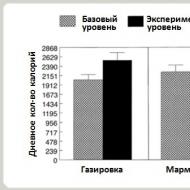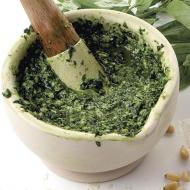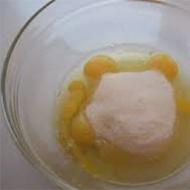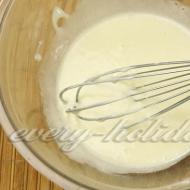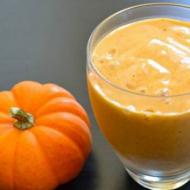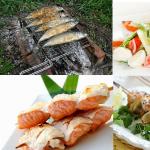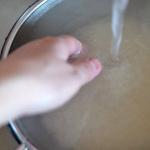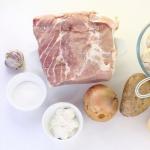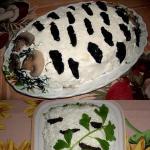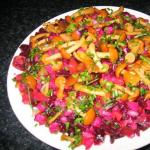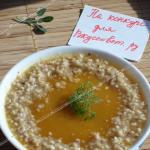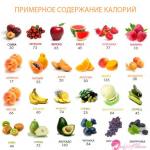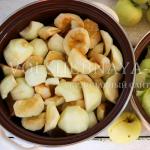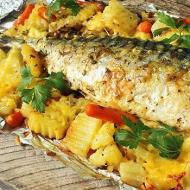
How to use basil in cooking, what dishes to add to and what spices to mix with. What is basil: composition, beneficial properties and harm to health, application What does basil go with in food?
Nowadays, every housewife knows what basil is. The use of aromatic herbs in culinary dishes has become traditional: the spice is actively used both as a seasoning and as a separate ingredient. In addition, the herb is very popular in folk medicine, beauty and cosmetology.
General information
Basil is an annual plant whose leaves are colored emerald or rich purple. The first type of herb is especially popular in Europe, where it is used in the preparation of Mediterranean dishes. The second variety, which has a sharper aroma, is loved in the Caucasus and Asia. Spice can smell completely different. One of the most popular in Russia is lemon basil: the use of seasoning adds pleasant citrus notes to soups and pastas. There are also clove, pepper, marinade, menthol, vanilla, anise and caramel odors of the plant.
In general, more than a hundred varieties of basil are cultivated in all corners of the planet. Each variety “loves” its own air temperature and humidity, so the species that grows in Asia cannot take root in Africa. In addition, climatic conditions also affect the appearance of the plant, its size, color and smell. Most often, basil can be found in Latin America, Mediterranean countries and Central Asia.
Composition and calorie content
Basil, the use of which is very beneficial for health, is known for its rich chemical composition. Firstly, it is a storehouse of vitamin C, as well as A, B2 and PP. Secondly, the plant boasts a high content of essential oil - up to 1.5%, as well as phytoncides and rutins. By the way, the first of the above substances is an antioxidant and has pronounced bactericidal properties. It contains such a useful substance as eugenol, which has a beneficial effect on human health and appearance.

It should be noted that the seasoning contains tannins, glycosides and other bioactive components. When losing weight, basil is also actively used, the properties, application and composition of which are indispensable during dietary nutrition. Obese people know that it is low-calorie: in its raw form it is 27 kcal per 100 grams, in dried form it is 251 kcal per the same serving. In addition, they know the effect of the plant on metabolism, which makes it easier and faster to lose excess weight.
Use in cooking
Basil is suitable for almost any dish. Use in cooking has its own characteristics: fresh herbs are added to cold appetizers and soups; in other cases, powder is often used, and dry plant stems are used for marinades. In the UK, for example, it is invariably seasoned with pates and stews, as well as dishes containing cheese and tomatoes. In France, the herb is an indispensable ingredient in ox tail and turtle soup soups.

Its further fate also depends on the aroma of the spice. Anise usually accompanies fish and vegetable culinary masterpieces, pepper and clove - meat products. But lemon basil is more suitable for drinks and sweet dishes, the use of which adds a refreshing effect to every dish. For such dessert versions of dishes, plants with caramel and vanilla aroma are also used. Experienced chefs say that basil can decorate crab and egg salads, but it is not suitable for bean and potato dishes. The plant creates amazing flavor notes together with savory - this duo enhances the pungency and spiciness of products.
ethnoscience
The plant is very helpful for sore throats. It is used to make an infusion for gargling and various compresses. The herb is used in the treatment of skin diseases, as it relieves inflammation, eliminates itching and calms pain. To do this, you need to take a dried plant (without root) and chop it. Then two tablespoons of powder are poured into 0.5 liters of boiling water, filtered and drunk 1/2 cup 3 times a day after meals. A hot decoction is also taken for inflammation of the bladder and kidneys, intestinal colic and flatulence, bronchial asthma and epilepsy, neuroses and headaches. If a patient has indigestion, he is recommended to drink this drink: a teaspoon of the plant is poured with boiling water and left for an hour in a dark place.
The use of basil in medicine is also supported by medical professionals. However, they advise consulting with your doctor, since this herb has a number of contraindications, especially during pregnancy. Despite the fact that it contains many vitamins and nutrients, the spice increases the tone of the uterus, and this can provoke premature birth.
Other beneficial properties and contraindications
Young mothers are allowed to consume basil in moderation. The seasoning, the use of which during pregnancy is under the strictest taboo, is beneficial during breastfeeding, as it significantly increases lactation. The plant also reduces menstrual pain, reduces high blood pressure and gives vigor. To treat migraines, it is recommended to apply a paste of leaves to the temples; after this procedure, a noticeable improvement occurs. Basil also promotes the active absorption of nutrients during meals and improves digestion in general. Herbal baths eliminate sweaty feet and unpleasant odors.

Despite this, there are a number of illnesses during which the spice is contraindicated. The plant should not be used after a stroke or heart attack, when a person has poor blood clotting, suffers from epilepsy, thrombosis or thrombophlebitis. Basil contains a lot of mercury compounds, so even healthy people can abuse it. You need to dose the essential oil especially carefully, and it is also not recommended to chew fresh leaves of the plant, since prolonged contact with teeth can damage the protective enamel.
Application in cosmetology
Basil oil is used for healthy skin. The use of the plant helps improve the elasticity of the epidermis and smooth out early wrinkles. The herb is not effective for deep damage and serious skin problems, so the oil is not suitable as a basic cosmetic product. But as an active additive for everyday care, it is welcome. The only exception is that basil cannot be used to eliminate warts; it can aggravate the situation and provoke inflammation and redness of the formations.

Effect on the nervous system
Essential oil from the spice is one of the most tonic, so it effectively and quickly affects the emotional sphere of a person. Spicy and aromatic basil literally clears the mind - the use of this miraculous herb has a direct proportional effect on the human nervous system. Namely, concentration and attention are restored, memory improves. The plant is called an optimist, as it not only relieves nervousness and lifts the mood, but also develops intuition and promotes decision-making to get out of difficult life situations.
Spice develops mental capabilities, helps cope with brain tension during its active work, and promotes creative thinking. Inhaling the aroma of basil essential oil, a person will definitely feel how his self-esteem, self-confidence, and adequacy of perception of surrounding people and current events are rapidly increasing. This oil can become the main weapon in the fight against complexes and depression. Basil is the best remedy for treating depression, addiction, stress disorders and chronic fatigue.
Preparing basil for the winter
In order for the plant to “work”, they need to be properly and competently stocked up for the winter. Basil, whose use in cooking is known to all the world's leading chefs, can be prepared in several ways: freezing, drying and pouring oil. Each of these options has its own advantages. For example, dried basil has a richer aroma, while oiled basil can retain maximum nutrients. As for frozen herbs, they are convenient for making soups and pastes.

The most popular method is still drying basil. In order for it to retain a maximum of vitamins and microelements, it must be collected correctly. This is usually done before flowering begins, otherwise the leaves become tough and hard, and therefore unsuitable for cooking. You need to dry the basil in the oven at a temperature of 40º degrees for an hour with the door ajar. After this, the stems and leaves are crushed and packaged in bags. More details on how to prepare basil, application, recipes and use of the plant can be found in any reference book on growing plants.
To make your basil as aromatic as possible, using the plant to decorate dishes with its scent and enrich them with useful substances, the dried plant should be stored away from sunlight. During cooking, the spice is added actually before the end of the heat treatment - 15 minutes before the end of cooking. In this case, the essential oils from the herb will not have time to evaporate. Basil cannot be cut with a knife; it is better to chop it with your hands - tear it into pieces.

If fresh leaves are poured with vinegar, basil will acquire a piquant taste and an unusual smell. They are recommended to season salads and sauces. This vinegar is an ideal addition to vegetable dishes. In order for basil to retain its properties, it can be salted. The grass in this form goes well with meat products. Chefs claim that basil is a truly unique seasoning, but you need to use this gift of nature carefully. After all, even the most useful plant, if used ineptly and illiterately, can cause significant and irreparable harm to health.
Dried basil is an aromatic spice that has unique beneficial properties and adds a rich taste to the dish. Initially, this herb was widely used in French, Greek, Italian, Georgian and Azerbaijani cuisine.
The popularity of the seasoning grew rapidly, and soon it became an element of the culinary culture of other peoples. However, the fresh leaves of the plant quickly deteriorated, and cooks began to look for a way to increase the shelf life of the spice. Drying basil made it possible to prevent the loss of beneficial and taste properties, as well as to prepare the seasoning for future use.
Use in cooking
In cooking, dried basil is most often used as a separate seasoning, but sometimes it is part of spice mixtures.
To impart an exquisite aroma to three kilograms of the final product, just a quarter teaspoon of the plant in dried form is enough.
What dishes are they added to? The seasoning will perfectly complement soups, pizzas, meats, risotto, omelettes, lasagna, cottage cheese casserole and stewed vegetables. The dried ingredient is an essential component of pesto sauce, along with grated Parmesan, garlic, pine nuts and olive oil.
The dried product is combined with tomatoes and sweet paprika. And this is not the entire list of dishes where spice is added. Basil adds flavor to beef and lamb. The spice is also used to prepare salads, winter preparations and even pasta.

Use for medicinal and cosmetic purposes
Dried basil is widely used not only in cooking; its daily use helps cope with various ailments; the use of cosmetics containing this herb can slow down the aging process.
This spice is used in medicine to treat whooping cough, prolonged bronchitis, neuroses, neuralgia, migraines, inflammation of the bladder and kidneys. It accelerates cell regeneration and also slows down the aging process.
Dry basil is used to prepare an infusion that stimulates the appetite and improves digestion. The benefits of the plant for women during lactation are invaluable. It increases milk production and enhances its protective properties.
The spice is used for visual impairment, bone fractures and bronchial asthma. There are positive results from using the herb in complex therapy in the treatment of cancer. How is basil useful in the fight against this serious disease? Of course, it is not a panacea, but it can slow down the formation of carcinogens in cells.
Basil contains fiber, vitamins and microelements. The plant is rich in iron, zinc, potassium, magnesium, manganese, phosphorus, selenium, calcium. The folic acid contained in it helps normalize the production of hormones in women.
Eating dry spices prevents the formation of blood clots, helps cope with headaches, relieves nervous tension, and increases the level of hemoglobin in the blood.
In winter, it helps strengthen the immune system. These beneficial properties of the plant are due to the content of phytoncides and vegetable fats in its composition.

How to dry basil at home
Making dried basil at home is easy. First, the grass should be washed and spread on paper towels. You can then place the dried herb in an electric dryer or oven and dry for five hours at a temperature of thirty-five degrees.
There is an alternative method of preparing the aromatic herb that does not require the use of machinery, but requires more time. Bunches of grass can be hung in a dark, well-ventilated area for several days.
After the leaves have dried, they should be separated from the branches, crushed into powder, placed in a paper bag or jar with a tight-fitting lid and stored in a dry place, protected from light.
Contraindications for use
In order for the plant to bring exceptional benefits, contraindications must be taken into account. Basil is not recommended for use in the presence of diabetes, thrombophlebitis, hemophilia, thrombosis and other diseases of the circulatory system, as well as for preschool children, pregnant women and people suffering from allergies or heart disease.
Dried basil has a wide range of uses. Drying it at home allows you to obtain a high-quality product that is not inferior in beneficial properties to a fresh plant.
Many spicy plants are well known today and are in demand in various areas of life! For example, such an aromatic herb as basil is today and always popular in culinary circles, and also finds a response in folk and official medicine, cosmetology and other industries. Like any other plant product, basil has beneficial properties and contraindications. This plant culture has a rather bright taste and aroma. And the variety of positive effects that can be expected from the use of this spicy herb completely exceeds all expectations. Why is basil interesting and useful? First things first!
Basil: beneficial properties and contraindications
Basil is also called regan! There are other names too. But in our latitudes you will most often come across precisely these two variants of the name - “regan” and “basil”. This is a cultivated annual plant that has been widely known in culinary circles since time immemorial. This spicy herb is known not only in cooking. Basil was used in ancient Egypt to embalm the bodies of the deceased. In India, this plant is revered to this day. For Hindus, basil is a sacred spice that is used in various rituals of invoking deities. For temperamental Italians, regan is a symbol of love and romance! In Romania, too, a sprig of this annual plant is a symbol of passionate and sincere feelings. If a Romanian young man accepted a sprig of basil from a girl, it meant that he recognized himself as her fiancé. The popularity of this spicy plant in Caucasian cuisine is widely known!
Regan is a heat-loving crop! This plant grows in countries with a predominantly warm climate. All over the world this culture is cultivated for various divergent purposes. In Russia, the crop also occupies a leading place in the ranking of food and medicinal plant products.
There are many varieties of this plant:
- Mediterranean;
- Asiatic;
- citric;
- Thai basil.
There are several varieties of each species. The color, taste and aroma of this spice depend on the type and variety. Basil leaves have curly edges and the color varies from soft green to purple-lilac. The aroma combines spicy mint, lemon, and cinnamon notes. This is an extremely tasty plant. Sourish freshness and subtle sweetness with a barely noticeable hint of bitterness are combined in the taste of leaves and stems. It is noteworthy that basil can be eaten raw, dried or frozen. This plant is often added to dishes that are prepared using heat treatment.
Basil: health benefits and harms
Before talking about the benefits and possible harm of this cultivated plant, it is worth taking a closer look at the composition.
Basil contains the following substances:
- Vitamins: B; WITH; TO; E; RR.
- Minerals: calcium; magnesium; potassium; manganese; copper; selenium, etc.
- Essential oils.
- Mono- and disaccharides.
- Amino acids.
- Saturated fatty acids.
Nutritional value per 100 grams of product:
- proteins - 3.15 g;
- carbohydrates - 2.75 g;
- fats - 0.65 g.
Total calories - about 27 Kcal per 100 grams of fresh product.
What are the benefits of basil for humans?
This cultivated plant is considered a natural aphrodisiac. The positive effect of this plant on the nervous system of the human body has also been proven. A little basil in your daily diet can literally work wonders. This plant saturates with a lot of useful substances and helps restore strength, strengthen the immune system, and receive a positive energy charge.
The following properties of basil are also distinguished:
- pronounced antiseptic effect;
- antipyretic effect;
- diaphoretic effect;
- antibacterial and antifungal protection;
- antitussive effect;
- sedative, analgesic, relaxing effect;
- anti-edema effect;
- expectorant effect;
- antioxidant, rejuvenating effect.
Basil is used to obtain positive dynamics in the treatment of diseases of the upper respiratory tract, urinary and reproductive systems, gastrointestinal tract, and cardiovascular system. Basil is a good therapeutic and prophylactic agent for the prevention (therapy) of whooping cough, sinusitis, influenza, sore throat, ARVI. With the help of this plant it is possible to improve sleep, stabilize the state of the nervous system, get rid of depression, and eliminate accumulated fatigue. This spicy plant restores the immune system after serious “shocks” and protects it in everyday life from the influence of many negative factors.
Basil: beneficial properties and contraindications for women
This spicy herb has a huge impact on the female body. In this direction, one cannot fail to note the pronounced antispasmodic and analgesic properties. This is very valuable during the period of menstrual changes in a woman’s body, during menopause and various gynecological diseases. The plant has anti-inflammatory and antibacterial effects. These properties should be used in order to protect the female body from diseases of the reproductive system of an infectious and other nature. When preparing for conception, it is also worth including (in the absence of contraindications) this plant in the diet. After all, basil contains substances that are important and necessary for the formation of a healthy background in a woman’s body, which will become a solid platform for creating a favorable environment for conception and pregnancy. To restore strength and saturate the body with “healthy juices,” you can use basil after childbirth. However, when breastfeeding, this plant is not always acceptable in a woman’s diet. Need specialist advice!

Benefits for men
It is believed that this cultivated plant is extremely beneficial for men's health. The vitamins and minerals contained in the leaves and stems of basil help preserve male strength and help prevent the development of prostate adenoma and other characteristic ailments. The antibacterial ability of this spicy herb is applicable in the prevention of urological diseases. Basil is good for the male nervous system. This plant is welcome as part of sports nutrition, as it helps strengthen the immune system, restore strength, and obtain the necessary vital energy.
Both men and women will appreciate the benefits of this plant for their figure. Basil helps remove excess fluid from the body, relieves swelling, and promotes gentle and safe weight loss.
Contraindications
Like any plant food, basil has a number of contraindications. Some prohibitions are conditional and temporary, but there are situations in which it is better to completely exclude this plant from your diet.
Contraindications include:
- individual intolerance to the plant;
- acute period of food allergy to other irritants;
- period of acute intestinal disorder;
- recovery period after heart attack and stroke;
- pregnancy and lactation;
- children under 6 years of age;
- exacerbation of hypertension;
- epilepsy.
Any chronic and acute diseases can cause undesirable reactions from the body when consuming a new product. Therefore, it is worth consulting with your doctor about the admissibility of including this spicy plant in your diet if you have pathological conditions or have been diagnosed with a chronic disease.
How and with what to eat basil
Regan has found wide application in cooking! It is added to salads, soups, vegetable mixes and sauces. However, the form of the product is different. It can be fresh basil, just picked from the garden, or a frozen, dried version of the product prepared for future use.
Delicious healthy teas are brewed with this plant. Basil is added to confectionery products. This cultivated plant is not only eaten and included in hot and cold drinks, but is also widely used in cosmetology and folk medicine. Basil is good for preserving the beauty of hair, increasing skin elasticity, and strengthening the nail plate. At the same time, the plant is used both in professional cosmetology and in folk cosmetology. There are a huge number of recipes for miraculous masks, creams, and rubs based on basil. If you study the labels of modern anti-aging, skin care and other products, you can also find some parts of this plant (extracts, extracts, juices). Basil juices and extracts are often included in shampoos, masks, and serums for hair restoration and care. Basil is good for teeth and gums. Therefore, it is often present as a component in mouthwashes and toothpaste.
How to Preserve Basil for the Winter
It is worth noting that this plant is quite unpretentious in care. Many amateur gardeners grow basil in their own beds. Of course, I would like this product to be preserved for the winter. Indeed, during the cold period, all the benefits that this plant gives to the human body are more important than ever.
You can prepare this herb for the winter in two ways. The first option is to dry it. The second option is to freeze. To do this, you need to pick fresh basil leaves and wash them thoroughly. Then you need to dry the foliage. For ease of subsequent use, the plant should be finely chopped with a knife. The finished suspension can be placed in food bags and placed in the freezer. Dry the basil by carefully spreading the washed, chopped leaves on a cotton towel or clean paper sheets. As soon as the foliage dries, it should be placed in a glass container and tightly closed with a lid. Dried basil is stored in a dark place (in a closet, cellar, on a shelf). A properly prepared product has a fairly long shelf life - up to 2 years for the dried version, up to 12 months for frozen basil.
Good idea!
There is another good option that allows you to enjoy basil all year round. This plant can be grown in special boxes at home. Some connoisseurs of fresh herbs grow herbs right on their windowsill or in another suitable place. In this way, you can grow unpretentious crops that can easily grow at home. Basil is just like that!
This is how bright, tasty and healthy it is - basil! Eat it, prepare healthy products based on it, enjoy its taste and appreciate the benefits. The main thing is that there are no contraindications and there is a desire! And it’s not difficult to figure out how to use basil for your own benefit!
Basil belongs to the Yamnotaceae family. Its genus is represented by annual or perennial plants. Basil is popularly called reagan, rayhon, rean or fragrant cornflowers.

Appearance
Some species have the form of subshrubs. The stems reach a height of 0.4-0.8 m and have a dark green color. The stem has branches, but no more than several rows of lateral branches.
Basil leaves are oblong, oval in shape, reaching several centimeters in length. They are light green in color, although in some species they are even purple. The leaves are planted on short cuttings. There are special glands with essential oils on the stem and leaves.
Basil blooms in the last month of summer. Its flowers are small, 5 mm each, and painted white or pink. They gather in inflorescences reaching up to 0.3 m in length.
At the beginning of autumn, the formation of fruits occurs, which are represented by very small black nuts.
Basil roots are branched and located in the upper part of the soil.


Kinds
In total, there are about 70 species in the genus. However, only a few are the most popular:
- Genoa basil (Ocimum basilicum): the most famous species, represented by annual plants with dark green leaves and white flowers. It reaches a length of up to 0.6 m. The species is very fragrant. Genoa basil has large, oval-shaped leaves that taper at the tips. They have a slightly convex shiny surface. The view is very popular in Italy, so it is the hallmark of Italian cuisine. In German, Genoese basil is called Gew?hnliches Basilikum, Suppenbasil, Braunsilge, in English – sweet basil, in French – basilic, grand basilic.
- Green curly basil (Ocimum basilicum ‘Green Ruffles’): This species has a very strong aroma with sweetish notes. The yields of such basil are very high. He is loved most of all in England. The species is represented by annual bushy plants reaching half a meter in height. The leaves are large, have a curly edge and lime color. There are related curly species with purple or reddish-brown leaves.
- Provençal basil (Ocimum basilicum): originated from the southern regions of France. Brings high yields, has narrow and smooth leaves of medium size with teeth along the edges. This species also has an intense aroma and is represented by squat annual plants.



There are other types of basil:
- Fino Verde basil (Ocimum basilicum): has an intense aroma and small dark green leaves;
- Greek bush basil (Ocimum basilicum var. minimum): the species is represented by annual bushy plants growing in a spherical shape. The height reaches 0.4 m. The leaves are small and have a strong aroma;
- Turkish bush basil (Ocimum basilicum var. minimum): sweetish aroma, leaves very small;
- lemon basil (Ocimum species): As the name suggests, it has a hint of lemon in its aroma. It reaches a height of 0.4 m, has narrow leaves;
- Mexican spiced basil (Ocimum basilicum): has notes of cinnamon in the aroma and the stem is red;
- Thai basil (Ocimum basilicum): an annual plant with notes of pepper in the taste and aroma of anise. The leaves become pointed and the flowers are colored red;
- Thai basil "Siam queen": similar to the previous species, only with darker leaves. Has the aroma of anise and licorice;
- wild basil (Ocimum americanum): has the scent of pimento and flowers painted in lilac tones. The taste is reminiscent of a mixture of mint and ginger;
- Wildes purple basil (Ocimum canum x basilicum): a massive plant with a bright aroma. Has red leaves and pink flowers;
- African blue basil (Ocimum kilimandscharicum x basilicum): has green leaves with red veins. The taste is tart, the smell resembles a mixture of cloves, anise and mint;
- Cypriot bush basil (Ocimum species): it has large, fleshy leaves and a strong basil aroma;
- Russian bush basil (Ocimum basilicum v.): has leaves of medium size and green color and has a strong aroma;
- Cuban bush basil (Ocimum basilicum v.): almost does not bloom, but has a strong aroma;
- Basil "Rothes Lesvos" (Ocimum basilicum): Its leaves are red-green and spotted. The flowers are colored pink;
- Bush basil "Corfu" (Ocimum basilicum ssp. minimum): it has fragrant and delicate leaves of small size and light green color;
- East Indian eugenolic basil (Ocimum gratissimum): it has large drooping leaves, the aroma has clove notes;
- Indian basil or tulsi (Ocimum tenuiflorum): it has a red-purple stem and green leaves with red veins. It has a spicy strong aroma, but is more often used in religious ceremonies.



Where does it grow?
The plant is thermophilic, so the regions where it is grown are predominantly southern. There are suggestions that Africa was the historical homeland of basil, however, according to some opinions, Asia can also be considered it.
Basil is now common in tropical and temperate climates. It is more common in the countries of the Old World (southern European countries, Africa).

Method of making spices
Fresh basil leaves or dried crushed leaves and flowers can be used as a spice.

How and where to choose a spice?
You can judge the quality of basil by eye. Basil is prone to wilting quickly, so when choosing it fresh, you need to take this into account. High-quality dried basil consists of large pieces of leaves without any side impurities. It has a strong aroma, and the leaves themselves are purple or dark green in color.
You can buy fresh or dried basil at any supermarket or spice stores.

Peculiarities
Certain types of basil are used to make sweets or tea. When stored properly, basil can retain its aroma and flavor for up to two years.

Characteristics
Basil has the following characteristics:
- is a spice present in dishes from cuisines all over the world;
- has a medicinal effect;
- can be used either alone or in combination with other herbs.

Nutritional value and calorie content
100 grams of fresh basil contains 23 kcal.
The nutritional value of the product is as follows:
- proteins – 3.15 g;
- fats – 0.64 g;
- carbohydrates – 2.65 g;
- dietary fiber – 1.6 g;
- ash – 1.49 g;
- water – 92.06 g;
- monosaccharides and disaccharides – 0.3 g;
- saturated fatty acids – 0.041 g.
You can learn more about basil and its properties from the video.
Chemical composition
The chemical composition of basil includes the following components:
- vitamins:β-carotene – 3.142 mg; A – 264 mcg; B1 (thiamine) – 0.034 mg; B2 (riboflavin) – 0.076 mg; B5 (pantothenic) – 0.209 mg; B6 (pyridoxine) – 0.155 mg; B9 (folic) – 68 mcg; C – 18 mg; E – 0.8 mg; K (phylloquinone) – 414.8 mcg; PP – 0.902 mg; choline – 11.4 mg;
- macroelements: calcium – 177 mg; magnesium – 64 mg; sodium – 4 mg; potassium – 295 mg; phosphorus – 56 mg;
- microelements: iron – 3.17 mg; zinc – 0.81 mg; copper – 385 mcg; manganese – 1.148 mg; selenium – 0.3 mcg.
The part of the plant that is located above the surface of the earth contains a large amount of essential oils that cause such a smell.

Beneficial features
Basil has a number of beneficial properties:
- the plant is an excellent antiseptic;
- basil is useful as an antidepressant;
- basil helps improve body tone;
- the plant is effective in aromatherapy;
- basil can help combat stress;
- considered an aphrodisiac.
In aromatherapy, basil essential oils are used, which have a general calming effect on the nervous system.

Harm
Unfortunately, basil also has some side effects:
- serious poisoning;
- irritation of mucous membranes;
- convulsions;
- allergic reactions.
Basically, such phenomena can only occur with serious overdoses.
Contraindications
Basil should not be consumed:
- pregnant women;
- for diseases of the cardiovascular system;
- after suffering severe heart disease;
- in the presence of blood clots;
- in case of poor blood clotting;
- in case of personal intolerance to the product.
Oil
Basil contains essential oils, most of which are concentrated in the leaves and inflorescences. The stem has a lower oil content.
Basil oil is obtained by steam distillation. There are 100 kg of fresh plants per liter of essential oil. The oil is colorless, but can sometimes be yellow (depending on the type of basil).
The use of oil is quite extensive. It is actively used in cosmetology; current skin care procedures cannot do without it. It allows you to smooth out wrinkles, slow down the aging process of the skin, make it firm and elastic. The oil is often added to various anti-aging products. It also controls metabolic processes in the body and maintains the balance of water and fats.
Basil oil is useful for improving blood circulation and for joint diseases. It is also used as an antiseptic. The chemical composition of the oil determines its effectiveness against colds and digestive system disorders.
Basil oil helps increase blood pressure.


Juice
Basil juice helps heal wounds or inflammations on the skin. It is obtained by squeezing the surface part of the plant before flowering. Basil juice tones the body and has a positive effect on the nervous system. It is used effectively in the treatment of respiratory diseases.
It is best to dilute the juice with water, otherwise it may irritate the esophagus.

Application
In cooking
Thanks to its spicy aroma and bittersweet taste, basil has found very wide use in cooking:
- seeds are added to soups, salads and even some drinks;
- used both fresh and dried;
- fresh basil is ideal for some types of meat;
- added to fish, vegetables, cheeses and soups;
- an indispensable ingredient in Italian cuisine;
- added to a variety of sauces;
- goes well with other spices and herbs;
- added to alcoholic drinks;
- used in the preparation of canned food and semi-finished products.
Genoese basil is very popular in Italy. Its leaves and shoots are added to salads and pesto, as well as to dishes with garlic, tomatoes, fish and other seafood, and eggplant.
Provençal and green curly basil have the same uses.
The aroma of different types of basil is different. Those that grew in Mediterranean countries have a sweetish peppery taste with notes of anise and cloves. Some other types have a distinct lemon or cinnamon flavor. Asian species have the aroma of camphor and anise.
Basil has excellent preservative properties, so it is included in many marinades and preservatives.



Basil should not be added to dishes during cooking, drying or freezing. Its bright aroma can be preserved exclusively in vegetable oil.
Certain types of basil are ideally combined with legumes, and are also involved in pickling vegetables. Basil is also added to vinegar to give dishes a more original taste.
In Italian and Mediterranean cuisine, basil is used to season pasta dishes, and it is also added to cottage cheese, cheese, egg and crab dishes.
Recipes
You can make a wonderful pesto sauce at home, which is very popular in Italy:
- you need fresh basil leaves, 100 ml olive oil, 100 g grated parmesan, 6-7 garlic cloves, a couple of tablespoons of pine nuts, salt and pepper;
- garlic is chopped very finely and ground in a mortar along with basil and nuts;
- then add the remaining ingredients, as well as pepper and salt to taste.

You can also make a simple but tasty salad with basil:
- cut an arbitrary amount (to taste) of cucumbers, tomatoes, bell peppers;
- add cheese cut into small pieces (preferably mozzarella);
- basil leaves are torn directly by hand and added to the salad;
- salt and pepper are added to taste;
- You can add olives to the salad, season it with olive oil and lemon juice.

In medicine
Basil has extensive medicinal uses. It is used:
- to reduce spasms;
- as an antispasmodic;
- as an antidepressant;
- as a tonic;
- for the treatment of cough and respiratory diseases;
- as an antiseptic;
- to calm the nervous system;
- as a diuretic;
- to improve blood circulation;
- to reduce headaches;
- for the treatment of gastrointestinal disorders.

Sometimes they even drink tea with basil. Thus, it has a beneficial effect on digestive processes. Basil is actively used for colds. It is known to help reduce high fever. Basil oil is an excellent remedy against insomnia and neurosis. Basil leaf juice is used to treat fungal infections. Gargle with infusions or add them to the bath. Asthma patients use basil to ease their breathing.

When losing weight
Due to the high content of enzymes, basil promotes faster breakdown of fats and more intense fat burning. This is what stimulates weight loss. Also, due to its diuretic and carminative effect, the plant removes excess fluid and harmful toxins from the body.
At home
Household uses of basil are as follows:
- used in cooking;
- used in cosmetic skin care products;
- is a medicinal plant;
- added to individual perfume compositions;
- serves as one of the main components of aromatherapy.


Growing from seeds
Basil grows best in warm climates. It is quite whimsical: it loves warmth, sunlight, moderate moisture and fertile soil. If the climate in the growing area of the plant is cool or temperate, then it is planted in greenhouses.
Landing
Basil seeds are planted in the soil at a shallow depth, maintaining a distance of 0.2 m between plants and 0.3 m between rows. It is taken into account that basil grows in the form of subshrubs. After planting, the seedlings need to be watered well.
A week after planting, the seeds sprout for the first time. If you propagate basil by cuttings, then first place the cut stems in water and wait until they take root. This usually happens within a week or a little later. After another couple of weeks, the plant is planted in the ground. This usually happens in early May.
The soil in which basil is grown must have a high level of fertility and drain water well. It is necessary to periodically feed and fertilize basil, otherwise it will have hard leaves that are unsuitable for food.
You cannot grow basil in one place for several years, otherwise it will begin to get sick. The plant must be looked after: periodically loosen the soil and remove weeds.



- The name "basil" comes from the Greek language, where "basileus" means "king".
- In India, basil is revered as a divine plant, an incarnation of Vishnu. The plant is used in sacrifices and for protection against evil forces.
- Basil is also of great importance in Christian culture, as there are opinions that it grew on the site where Christ was crucified.
- Despite the fact that basil was once actively cultivated in many countries, it was not always held in high esteem, as it was associated with black magic. The plant was considered poisonous. Basil was also believed to bring bad luck.
- The ancient Egyptians used basil in compositions to mummify bodies and also as a repellent.
- Basil stems are used to make rosary beads.
In the article we discuss basil - how to use the plant. You will find out what seasonings the spice goes with. We will tell you how to add basil to meat dishes, winter preparations, sauces and desserts.
How to use basil in cooking
Fresh and dried basil is used in cooking
Basil is called the royal herb. It is widely used in cooking, adding to main dishes, salads, snacks, sauces and drinks.. Basil greens are popular in Mediterranean and Asian cuisines.
Fresh or dried basil leaves, as well as its seeds, are used as an aromatic seasoning. The taste of the spice in the finished dish reveals itself gradually - first the basil gives a bitterness, then a sweetish aftertaste appears.
What to eat basil with:
- meat;
- fish;
- vegetables;
- legumes;
- dairy products;
- eggs.
What dishes do you add fresh basil to?
Young basil leaves are added to appetizers, salads and sandwich mixes. Greens are used for canning and making marinade. Basil goes well with meat, fish, vegetables and legumes.
It is added to tomatoes, eggs, sauerkraut, spinach and cheese. Various sauces are prepared based on basil, for example, the famous Italian pesto.
What dishes are dried basil added to?
Dried basil is used as a seasoning. At the same time, it can be an independent spice or a component of ready-made seasonings: suneli hops, Provençal herbs, Italian herbs and bouquet Garni.
Basil - what is the seasoning for:
- salads;
- meat dishes;
- fish dishes;
- beverages.
Dried basil adds a bitter taste and spicy aroma to dishes.
Basil seasoning - application:
- The basic rule in using seasoning is to add it to the dish at the final stage of cooking. This way the basil will retain its beneficial substances and rich aroma.
- The spice is added to the minced meat at the kneading stage. On average, you need to put 0.5 grams per serving of food. dried basil.
How to use basil in meat dishes
 Basil goes well with meat
Basil goes well with meat
Basil gives meat dishes a unique taste and spicy aroma. Greens are added to meat salads and main dishes of pork, beef and poultry. These basil dishes combine thyme, lemon and walnuts.
Fresh leaves are added to meat goulash and gravy. In tandem with tomato and garlic, basil emphasizes the taste of meat and makes it more piquant. Consider a recipe for pork with basil.
You will need:
- pork - 1 kg;
- basil - 7 leaves;
- rosemary - ½ teaspoon;
- paprika - ½ teaspoon;
- onion - 1 pc.;
- olive oil - 1 tablespoon;
- garlic - 3 cloves;
- tomato paste - 2 tablespoons;
- salt and pepper - to taste.
How to cook:
- Cut the meat into pieces, marinate in olive oil and spices.
- Wash, dry and finely chop the greens.
- Place the meat over medium heat.
- Add finely chopped onion, garlic and tomato paste to it.
- Simmer covered for half an hour.
- Add chopped herbs and simmer for another 10 minutes.
Calorie content: Calorie content per 100 g. product 185 Kcal.
How to use basil for winter preparations
Basil is used for preserving vegetables and fruits. Fresh leaves are added to berry compotes and jams.
To prepare cucumbers or tomatoes for the winter, a combination of basil and horseradish root is suitable. Place 5-6 leaves of the plant on a three-liter jar.
The most popular jam using basil is raspberry with mint. It strengthens the immune system and eliminates the symptoms of colds.
You will need:
- raspberries - 1 kg;
- basil - 5 leaves;
- mint - 7 leaves;
- lemon zest - 20 g;
- granulated sugar - 500 gr.
How to cook:
- Rinse the raspberries, add sugar and leave for 20 minutes to release the juice.
- Place the container with raspberries on the fire and bring to a boil.
- Remove from heat, cool. Repeat the heating procedure 2 more times.
- Place the mint and basil leaves in a gauze bag, add the lemon zest and place them into the jam during the final heating.
Calorie content: Calorie content per 100 g. product 159 Kcal.
How to use basil to make sauces
Basil is used to make ketchups, sauces and various dressings. They make the dish more harmonious, adding piquancy and aroma.
Fresh herbs are chopped and mixed with the remaining ingredients for the sauce. Basil is often combined with tomatoes, cheese, olive oil and other herbs. Such dressings are suitable for pasta, meat and fish dishes. Consider the recipe for the popular Pesto sauce.
You will need:
- basil - 1 bunch;
- parmesan - 50 gr.;
- pine nuts - 30 gr.;
- garlic - 3 cloves;
- olive oil - 100 ml.
How to cook:
- Wash and dry the basil leaves.
- Grate the cheese.
- Peel and chop the garlic.
- Mix all ingredients in a blender.
Calorie content: Calorie content per 100 g. product 675 Kcal.
For more information on how to make basil pesto, watch this video:
Using basil in desserts
Basil, along with mint, is often used to make desserts. Greens go well with fresh fruits, dairy products and baked goods. Basil is added to desserts in the form of a dry seasoning or fresh herbs. Fresh leaves are used to decorate cakes, pies and casseroles. Consider the recipe for basil cream.
You will need:
- milk - 150 ml;
- chicken egg - 1 pc.;
- corn starch - 5 g;
- cream - 100 ml;
- granulated sugar - 20 gr.;
- basil - 15 leaves.
How to cook:
- Wash and dry the basil, chop finely.
- Put the milk on the fire, add the basil and bring to a boil.
- Beat the egg with sugar and starch.
- Slowly whisk the egg mixture into the boiling milk.
- Continue cooking the cream until it thickens. Stir constantly.
- Remove from heat and let cool.
- Whip the cream to stiff peaks.
- Add them to the cooled cream.
- Stir, place in bowls and refrigerate for half an hour.
- The finished dish can be decorated with basil leaves.
Calorie content: Calorie content per 100 g. product 114 Kcal.
What seasonings does basil go with?
When combined with rosemary, basil imparts a mild peppery flavor. The seasoning is combined with thyme, parsley, coriander, mint, marjoram and tarragon.
What to remember
- Young basil leaves are added to appetizers, salads, meat and vegetable dishes.
- Dried basil is used as a seasoning.
- The spice is added to the dish at the final stage of cooking.


